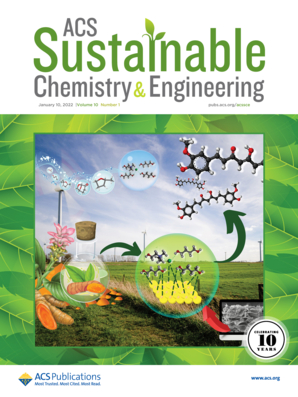CO2-Switchable High Internal Phase Pickering Emulsions Stabilized by Small-Molecular Surfactants and Hydrophilic Silica Nanoparticles
IF 7.3
1区 化学
Q1 CHEMISTRY, MULTIDISCIPLINARY
引用次数: 0
Abstract
High internal phase Pickering emulsions (HIPPEs) have received increasing attention recently due to their unique viscosity and rheological characteristics. Nevertheless, their high viscosity might limit their applications in the transportation field. Developing HIPPEs with adjustable stability, controllable viscosity, and easy preparation remains a challenge. Here, we reported an O/W HIPPEs costabilized by a novel CO2-switchable nonionic surfactant (NCOEO3) and hydrophilic silica nanoparticles with low concentrations, facilitated by the adsorption of NCOEO3 onto the nanoparticles through hydrogen bonding. Upon increasing the NCOEO3 concentration to 1 mM, the oil volume fraction of the emulsions can be adjusted to 92%. The HIPPEs demonstrate remarkable CO2 responsiveness due to the reversible transformation of the surfactant structure between nonionic (NCOEO3) and cationic-nonionic (N+COEO3) forms triggered by CO2. This responsiveness enables efficient demulsification at room temperature as well as the recycling and recovery of the surfactant within the aqueous phase. More importantly, the inverted highly viscous HIPPEs could be reversibly converted into flowable low viscous HIPPEs through the CO2 trigger. This research offers an effective method for preparing intelligent HIPPEs with adjustable properties, such as stability, viscosity, and an aqueous recyclable emulsifier, which can meet various practical application needs.

由小分子表面活性剂和亲水二氧化硅纳米颗粒稳定的co2可切换高内相酸洗乳剂
高内相皮克林乳剂(hipes)由于其独特的粘度和流变性能,近年来受到越来越多的关注。然而,它们的高粘度可能会限制它们在运输领域的应用。开发具有可调稳定性、可控制粘度和易于制备的hipes仍然是一个挑战。在这里,我们报道了一种新型的co2可切换非离子表面活性剂(NCOEO3)和低浓度的亲水性二氧化硅纳米粒子共同稳定的O/W hipes, NCOEO3通过氢键吸附在纳米粒子上。当NCOEO3浓度增加到1 mM时,乳状液的油体积分数可调节到92%。由于表面活性剂结构在CO2作用下发生了非离子型(NCOEO3)和阳离子-非离子型(N+COEO3)的可逆转变,hipes表现出了显著的CO2响应性。这种响应性可以在室温下实现高效破乳,并在水相中回收表面活性剂。更重要的是,倒置的高粘性hipe可以通过CO2触发器可逆地转化为可流动的低粘性hipe。本研究提供了一种有效的方法来制备具有可调性能的智能hips,如稳定性、粘度和水性可回收乳化剂,可以满足各种实际应用需求。
本文章由计算机程序翻译,如有差异,请以英文原文为准。
求助全文
约1分钟内获得全文
求助全文
来源期刊

ACS Sustainable Chemistry & Engineering
CHEMISTRY, MULTIDISCIPLINARY-ENGINEERING, CHEMICAL
CiteScore
13.80
自引率
4.80%
发文量
1470
审稿时长
1.7 months
期刊介绍:
ACS Sustainable Chemistry & Engineering is a prestigious weekly peer-reviewed scientific journal published by the American Chemical Society. Dedicated to advancing the principles of green chemistry and green engineering, it covers a wide array of research topics including green chemistry, green engineering, biomass, alternative energy, and life cycle assessment.
The journal welcomes submissions in various formats, including Letters, Articles, Features, and Perspectives (Reviews), that address the challenges of sustainability in the chemical enterprise and contribute to the advancement of sustainable practices. Join us in shaping the future of sustainable chemistry and engineering.
 求助内容:
求助内容: 应助结果提醒方式:
应助结果提醒方式:


